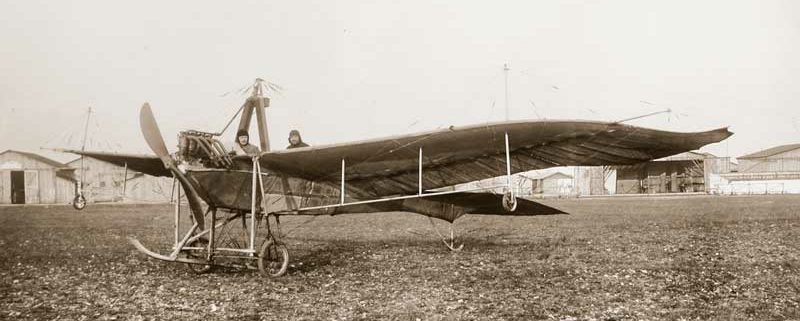Porsche’s first aviation engine
It was with good reason that Ferdinand Porsche was called a universal genius. In addition to automobiles, racing cars, prime movers and tractors, he also became renowned for his inventions in the aviation sector. As early as the beginning of the 20th century, he was building aviation engines. For example, for the first manoeuvrable blimp, the”Parseval”, in Austria in 1909. He created a special four-cylinder engine with valves in a lateral T-layout and double ignition system. Ferdinand Porsche personally supervised the performance of his 60 horsepower strong engine during the 20 minute maiden voyage of „Parseval” on 26 November 1909. The zeppelin was in service until 1914; at that time, the operation was terminated for reasons of inefficiency due to pending repair costs.
„Möwe” from Ingo Etrich
In 1910, Porsche prepared an aviation model of their Prinz-Heinrich four cylinder engine for the small racing aircraft „die Möve” (the seagull), constructed by Ingo Etrich and Karl Illner. With 40 horsepower at 1450 rpm, the engine achieved good flight performance. Unfortunately, „die Möve” crashed in Hungary.
First Austro-Daimler aviation engine
Warchalowski Double decker with AD four-cylinder engine, 1911.
Ferdinand Porsche developed the first Austro-Daimler aviation engine in August 1910. In its original design with four cylinders, the engine weighed only 80 kg with a displacement of 3770 cc. It had been planned with 35 hp, but ultimately delivered 48 hp at a displacement of 1450 rpm. The engine was followed by a version with a bore enlarged to 120 mm and 6333 ccm at a performance of 65 hp at 1350 rpm, which was preferred by the customer.
Porsche’s constructions were particularly appreciated for their endurance – contrary to some of its competitors in the aviation industry, who merely produced „one-hit-wonders”. He only allowed his engine to be installed in an aircraft once it had operated under load with a propeller on the test stand for ten hours.
Six cylinder aviation engine
The demand for higher motor output became louder. Porsche faced the challenge and added two more cylinders to his engine. Later, this six cylinder aviation engine was considered a milestone in the development of aviation engines. In 1917, his six-cylinder engine achieved 225 hp at 1400 rpm. Later on, he also developed his first V12 cylinder on the basis of the six cylinder for the k. u. k. war navy with 300 hp at 1250 rpm (Series 20000) and 345 hp at 1350 rpm (Series 20100).
A presentation will be held at the Oldtimer exhibition of the fahr(T)raum in Mattsee/Salzburg by Koloman Mayrhofer and Sebastian Knapp entitled „Flug(T)raum” on 20 May 2021 at 7:30 pm. It discusses the history of both planes „Hansa Brandenburg C1„, which was equipped with a 225 hp Austro-Daimler engine and the „Klemm 20„, the revolutionary light airplane. Further information and presale of tickets can be found HERE.
Quellen
Text:
fahr(T)raum
Ludvigsen, Karl: Genesis eines Genies
Bildnachweis
Bilder © Ludvigsen, Karl
This might also interest you:








The Klemm L20 project
/w Bez kategorii, Flugzeuge, GeschichteThis elaborate project was launched by Ernst Piëch, the grandson of Ferdinand Porsche, his head of design of the engineering office and board member of Daimler-Motoren-Gesellschaft. The idea for the project stemmed from the original Daimler F7502 aircraft engine with series number 66481. There were also family ties with the “L´École D´Aviation Mircea Cantacuzino” flight […]
1st overland flight of the Hansa Brandenburg C1 at Modellsporttage in Mattsee
/w Bez kategorii, Flugzeuge, ModellsportThe Ferdinand Porsche Erlebniswelten fahr(T)raum Model Sport Days took place last weekend for the 5th time in perfect late summer weather. Despite many parallel events taking place in the vicinity, the annual highlight for family and model enthusiasts on the Unerseehügel in Mattsee was again very well attended. In addition to skilful model air shows, […]
NEW: Gondola model with aircraft motor of the Parseval airship (1909)
/w Bez kategorii, FlugzeugeA Ferdinand Porsche / Austro-Daimler construction Aside from the development of racing cars, Ferdinand Porsche is also regarded as a pioneer in Austro-Hungarian military aviation. In 1909, the Reich Ministry of War introduced dirigible balloons into the Austro-Hungarian Army and built a military airship hangar in Fischamend. The first test flight of the M.I military […]